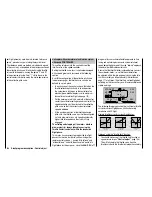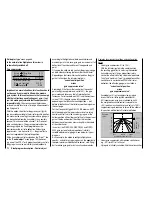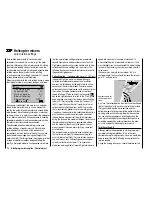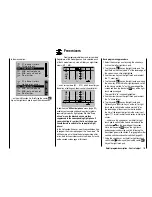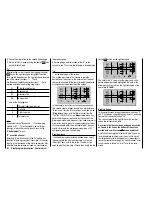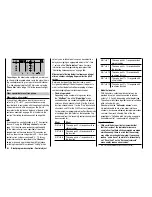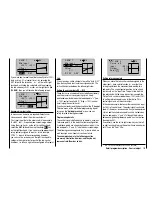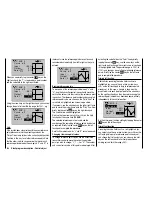
177
Detail program description - Control adjust
blades spinning wildly.
Always make sure that nobody else
is standing near the helicopter
where they could be injured.
In addition, you must never switch abruptly from idle
to the fl ight setting by suddenly increasing system
rotational speed. This will cause the rotor to accelerate
very quickly, resulting in premature wear to the clutch
and gear train. Since the main rotor blades are generally
mounted on a freewheeling unit, they will be unable
to keep pace with such rapid acceleration; they will
respond by swinging far out of their normal position and
may even cause a boom strike.
After starting the motor, you should therefore use the
throttle limiter to increase the system rotational speed
slowly
. If you have assigned a switch to the throttle
limiter, always ensure that you use the "
Control adjust
"
menu (page 100) to program a time constant of about
5 seconds for running up the system rotational speed
(opening the throttle limiter). Do not, however, program
a delay for closing the throttle limiter. Leave the default
value of "GL" in the "Type" column alone, however, to
confi gure this setting globally for all fl ight phase
Once the model can fl y this maneuver properly, set the
value for "Throttle min" – the value for point "L" on the
graph page for "C1
throttle" – so that the rotational
speed neither increases nor decreases. This completes
the set-up procedure for throttle and collective pitch.
Some important closing remarks
Before starting the motor, ensure that the throttle limiter
is fully closed: this ensures that the carburetor now
responds only to the C1 trim lever. If the carburetor is
open too far when you switch on the transmitter, you will
receive a visual and audible warning. Otherwise, if the
carburetor or speed controller is open too far when the
motor starts, there is a danger that the motor will run up
to speed immediately after starting, and the centrifugal
clutch will engage immediately.
Accordingly, you should
always hold the rotor
head fi rmly when starting.
However, if you should accidentally start the motor with
the carburetor too far open, the golden rule is this:
Don't panic!
Keep hold of the rotor head !
Don't let go!
Instead, close the throttle limiter immediately, even if
this risks damaging the drive system (in the worst case
scenario).
YOU are responsible for ensuring
that the helicopter never fl ies off
in an uncontrolled manner.
The costs of repairing a clutch, a gearbox or even the
motor itself are negligible, if you compare these to
the injuries and damage that an uncontrolled model
helicopter can cause if it is allowed to fl y around with its
hovers below the mid-point, correct this by reducing the
angle of attack appropriately.
You may also fi nd that it is necessary to correct the
carburetor opening for the hover point (point "1") at "C1
throttle".
This diagram shows only the
change to the hover point, i. e.
collective pitch minimum and
maximum are both left at -100%
or +100%.
+100%
-100%
OUTPUT
2
3
4
5
1
Control travel
Continue adjusting these settings until you really do
achieve a constant rotational speed over the full control
range between hover and climb.
Descent setting
The descent setting should now be confi gured by
placing the model in a steady descent from forward fl ight
at a considerable altitude by fully reducing collective
pitch; adjust the collective pitch minimum value (point
"L") so that the model descends at an angle of 60° …
70°. On the "Pitch" graph page, you should therefore
use the collective pitch stick to move the vertical line
to point "L" and change its value accordingly, using the
arrow keys on the right touch pad.
This diagram shows only the
changes when setting the
minimum collective pitch value.
+100%
-100%
OUTPUT
2
3
4
5
1
Control travel
Hover
point
Summary of Contents for mx-20 Hott
Page 41: ...41 Your notes...
Page 49: ...49 Your notes...
Page 55: ...55 Your notes...
Page 81: ...81 Your notes...
Page 85: ...85 Your notes...
Page 89: ...89 Your notes...
Page 99: ...99 Detail program description Control adjust...
Page 127: ...127 Detail program description Control adjust...
Page 131: ...131 Detail program description Control adjust...
Page 163: ...163 Detail program description Control adjust...
Page 191: ...191 Detail program description Control adjust...
Page 207: ...207 Detail program description Control adjust...
Page 228: ...228 Detail program description Control adjust...
Page 229: ...229 Detail program description Control adjust...
Page 251: ...251 Detail program description Control adjust...






